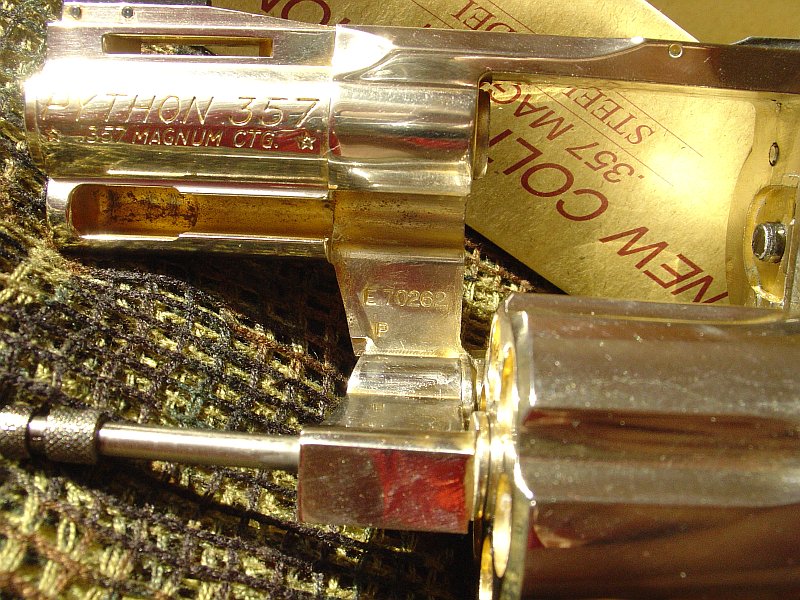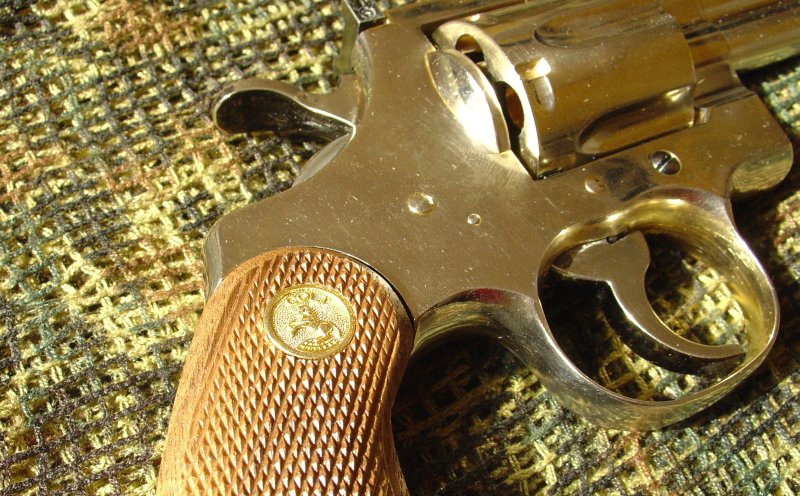HistoryColt is probably the best known manufacturer of revolvers. For many people "colt" is a synonym with "revolver". Colt Manufacturing Company shares CMC acronym with a certain modelgun manufacturer, interesting, isn't it? :-) Apart from revolvers Colt produces (but not always designs) other weapons such as 1911 pistols, CAR-15/M4/M16 rifles.
Colt revolvers can be roughly divided in two categories: old single-action (mostly Western guns such as SAA) and modern double-action based on a variety of frame types (sizes).
"Python", introduced in 1955, is based on I-frame type, medium size. It was supposed to be a .38 Special target revolver, but design evolved a bit and became chambered in .357 Magnum. Python is a premium model, called Rolls-Royce of revolvers, assembled with high quality and precise tolerances. Production ended in 1999, with small series released until 2005.
Wikipedia information about Colt Python series:
http://en.wikipedia.org/wiki/Colt_PythonOther Python information:
http://world.guns.ru/handguns/hg69-e.htmMovies where this revolver was featured:
http://www.imfdb.org/index.php/Colt_PythonModelgunRevolvers were very popular among modelgun makers right from the beginning and Colt Python is fairly well represented. It was already released as a modelgun in 1969 by MGC, and a year later by CMC. Kokusai started producing Pythons in 1970s. There was also a Malugo version. All of these were released in full metal. MGC also had ABS, HW and SRHW versions, Kokusai apart from metal had ABS and FexHW (similar to SRHW) versions.
Each model underwent many construction changes over the years, you can find more information under links below.
Links to Japanese websites with plenty of information about these modelguns:
http://homepage3.nifty.com/nkoinuma/ColtDAR2.htmhttp://www.geocities.jp/digi_hiro2000/py-mgc.htmlhttp://www7a.biglobe.ne.jp/~yon-yon/cgi/kokusai/python_1/index.htmlhttp://www7a.biglobe.ne.jp/~yon-yon/cgi/kokusai/python_2/index.htmlhttp://www7a.biglobe.ne.jp/~yon-yon/cgi/test3.cgi?Input2=pythonI am not that much into revolvers, although I do like the small ones that remind me of movie detectives

I originally bought a Kokusai M10 FBI to have an example of a modelgun revolver. It promptly self-destructed hammer and did not work well after only a hundred shots. Intrigued by S&W Model 2 design I got a kit and assembled it - failure to make it work at all convinced me NOT to work with kits...
Kokusai Colt Python with 2.5" barrel was more of an impulse buy. It was all metal, fairly small and looked much more solid than the ones I already had. If you read this forum you probably know that modelguns have psychic abilities and they force you to buy them, as did this one.
As far as I can say this is the latest production, probably a 5th revision of the construction. Earlier revisions can differ from what you see described here.
BoxUpper part of the box is made of yellow/brown cardboard. Top and sides are marked with the following text (in English): "NEW COLT PYTHON", ".357 Magnum", "Steel Model". There is also a JASG sticker and a longer description at the top:
- Quote :
- COLT python : double-action revolver, 6-rd, swing-out cylinder 37 magnum only, but will handle .38 Special, made first appearance in 6 barrel, later with 2 1/2" 4" - checkered walnyt grups contured for support for middle finger of shooting hand, vent rib barrel, ramp front sight, rear adjustable for windage, elevation, full-length ejector rod shroud, wide-spur hammer, grooved trigger, blued, nickel finish. Introduced in 1955, still in production. Used values, blued.
Opening the box you will find a single A5 sheet with exploded diagram and parts price list, plus some more text around these. Model itself is under a cardboard insert with a cutout window through which you can see the cylinder.
When box is fully open, you will discover a styrofoam lower part of the box, with several cutouts. One of them should hold revolver itself, another a box of six cartridges and a plastic loading tool. The same box is used for all three barrel lengths (6", 4" and 2.5") so the main cutout fits all of them.


 Modelgun
ModelgunNice, heavy and shiny :-)
It's probably not made of steel, but it looks and weighs as if it were. All parts are made of metal, grip panels of wood. Originally model was golden (due to Japanese regulations for metal modelguns) but somewhere along the way plating was (mostly) removed and main parts look now chrome-polished, except for yellow streaks in grooves and other hard to reach places. With some fine-tipped tools these should be clearable, too.
Note: due to strong Sun shining in photos, the surface of model looks heavily scratched. In reality surface is very uniform and does not show such scratches, except for these particular lighting conditions.

Where to start... Revolvers look more complicated than pistols, as there is so many controls, details and mechanism pieces that stick out of the grip/slide.
Barrel is short, just 2.5", but it is packed with features. Original barrel is fully blocked, starting at depth of about 1cm from the front, going all the way to the back (no outlet), according to Japanese regulations. On top of the barrel there is a sort of bridge that allows a ramp front sight (painted black) to be high enough. Under barrel you will find extractor rod that is almost fully covered by a metal tunnel. Left side of the barrel is marked "PYTHON .357" and "* .357 MAGNUM CTG. *". Right side is engraved with "COLT'S PT F.A. MFG. CO." and "HARTFORD. CONN, U.S.A."


Cylinder sits in frame behind the barrel, in a standard alignement. It holds 6 cartridges, and swings to the left after you press towards the back a release button located behind the cylinder. Serial number (?) is hidden under swinging arm. Mine says "E70262" and letter "P" underneath. Cylinder is blocked with inserts at the front, once again due to Japanese regulations. The insert includes detonator pins on the inside, there are also moon-shaped vent holes towards the outside. Area where cylinder goes features typical revolver mechanism - rear lock "button" and two protruding pieces. One locks cylinder in position, the other rotates cylinder when hammer is cocked or trigger pulled. There is also a spring-loaded firing pin that will strike cartridge when it is hit by hammer.



Hammer does not have a firing pin, it only pushes the one in frame. Hammer was originally black painted, now polished. It has a large, checkered hammer spur. Bottom of the hammer is the only place where you can see moulding seam.

Rear sight is on top of the frame, near the back. Painted black, it is fully adjustable - one screw controls left/right, another up/down movement of the sight.

Flat area of frame behind revolver, under cylinder release button has an engraved Colt logo.
Inside trigger guard there is a trigger. Guard is marked with a "P" inside an upside-down triangle near the front attachment point and "O" near the back. I have no idea what it means.
Grips are made of real wood, with inlaid golden-colour Colt logo medallions.

Except for several screws (two heads on the left, one on the right) and pins (two for front sight, one for rear sight, one hammer ax, one near hammer ax) there is not much more going on with the frame.

 Magazine
MagazineCylinder with a capacity of 6 cartridges.
When closed it is blocked and does not rotate freely while inside the revolver, different from some other revolvers. This means you can't just spin the cylinder, and can't play russian roulette with this model.
As mentioned, chambers have inserts and only partially went to the front.

 Cartridges
CartridgesThis modelgun uses open-style cartridges. Cartridge is made of two parts - outer shell, and an internal piston that pushes cartridge onto detonator pin. Piston is spring loaded, it returns to normal position by itself. Caps are actuall inserted onto the piston.
5mm cap is inserted from the front into the opening in the cartridge. It does not go fully inside, sticks out 1-2mm above the cartridge. This is not a problem, there is enough clearance when cartridge is in the cylinder.



 Firing
FiringLoad cartridges, open cylinder, put the cartridges in, close cylinder.
Colt Python is a double-action revolver, which means that you can just pull the trigger to shoot it. Trigger pull will cock the hammer and rotate cylinder. You can also cock hammer first, cylinder will rotate and trigger will move to a "cocked" position. Hammer sits very far to the back, it travels a long way when released. You can uncock revolver in the usual way - put a thumb on hammer to keep it backwards, pull trigger to release hammer. Next remove your finger from the trigger and very slowly move hammer to the forward position.
Yup, forgot to load cartridges for this picture
Back to firing...
Pull the trigger and FIRE! and again, and again... you can get at most six shots :-)
If a particular cartridge does not fire, you can just pull trigger again to fire the next one. This is advantage of revolvers over pistols :-)
In case you plan to test just one cartridge - cylinder rotates one position to the right while cocking the hammer. For DA this means that the cartridge immediately to the left of topmost position will fire. For SA this is cartridge in topmost position, because cylinder is already rotated when hammer was cocked.
After firing you can open cylinder and push cartridges out of chambers - just push extraction rod towards the back.
 Problems
ProblemsI found no major faults :-)
Occasionally cylinder locks - you cannot cock hammer or pull trigger. This seems to happen after cylinder is opened and closed, probably when mechanism ends up misaligned.
Front sight is wobbly. It is held firmly in the frame, yet moves around easily.
Basic disassemblyI have not attempted it yet, but process is probably similar to other revolvers. Start by unscrewing two screws at the left side (over trigger and over grip panel). You should be able to remove left plate and see trigger mechanism inside.
OverallI am still not 100% convinced to revolvers ;-)
Colt Python is however a fine piece of revolver and I am happy that I have it in my collection.
